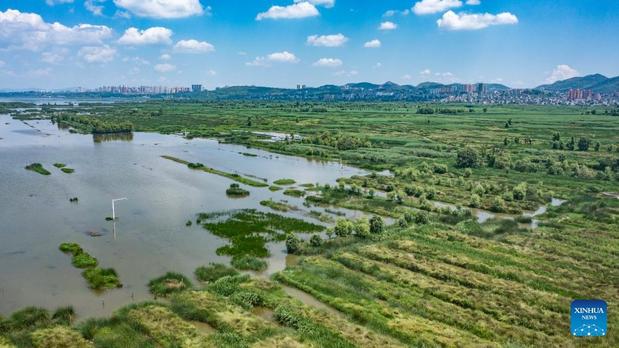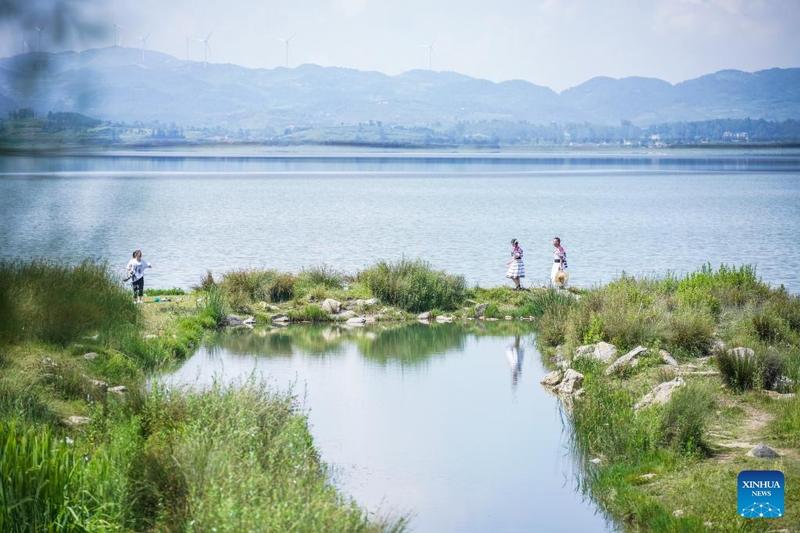 This aerial file photo dated to July 8, 2022 shows the Caohai National Nature Reserve in Weining Yi, Hui and Miao Autonomous County, southwest China's Guizhou province. (PHOTO / XINHUA)
This aerial file photo dated to July 8, 2022 shows the Caohai National Nature Reserve in Weining Yi, Hui and Miao Autonomous County, southwest China's Guizhou province. (PHOTO / XINHUA)
GUIYANG – With a camera snapping photos of migratory birds, Liu Guanghui starts his daily patrol in Caohai National Nature Reserve in southwest China's Guizhou province.
The 54-year-old is vice-captain of the team patrolling Caohai Lake, a primary wetland area in the Yi, Hui, and Miao Autonomous County of Weining. It is one of the largest wintering locations for black-necked cranes, a species under first-class national protection.
Thursday marks this year's World Wetlands Day. Over the years, China has stepped up efforts in ecological conservation, with significant progress made in protecting and expanding wetlands through the construction of national parks, restoration of shrinking wetlands and other measures
"The priority of our current work is to dynamically record the populations of the migratory birds and observe their activities to help them overwinter," said Liu, who has been patrolling the area for over three decades.
Every mid-November, hordes of migratory birds fly to Caohai reserve to spend winter. "This is a ruddy shelduck, and that is a bar-headed goose," said Liu, pointing at the birds.
Liu is also a shutterbug who loves taking photos of migratory birds, which, in his eyes, is an objective way to record bird species changes in this area. Many photographs of rare birds are in his home.
ALSO READ: Back from the wild
"The majority of migratory birds are vigilant, so I take the snapshots quickly," said Liu. It sometimes took Liu several days to keep watch on them during harsh winters to capture their natural and unique habits.
Thursday marks this year's World Wetlands Day. Over the years, China has stepped up efforts in ecological conservation, with significant progress made in protecting and expanding wetlands through the construction of national parks, restoration of shrinking wetlands and other measures.
Over the years, the populations and types of wintering rare bird species in the Caohai reserve have increased. This year it welcomes oriental white storks, an endangered bird species.
 This photo dated to Dec 22, 2022 shows that black storks forage at Mianman River in Jingxing County, north China's Hebei Province. Black stork is a migratory bird species under first-class national protection in China. There are fewer than 1,000 remaining in East Asia. (PHOTO / XINHUA)
This photo dated to Dec 22, 2022 shows that black storks forage at Mianman River in Jingxing County, north China's Hebei Province. Black stork is a migratory bird species under first-class national protection in China. There are fewer than 1,000 remaining in East Asia. (PHOTO / XINHUA)
The reserve is home to over 100,000 wintering migratory birds, including grey cranes, bar-headed geese, and black-necked cranes, among other species. The number of wintering black-necked cranes has reached 2,588.
This season's cold wave has caused trouble for the wintering birds to forage. To ensure these birds have ample food, the reserve's management committee has launched a feeding program since Jan 15.
"Over 1,000 kg of grain is provided per day, and the feeding will continue until mid-March," said a staffer with the management committee.
READ MORE: WWF: China on right path to tackle illegal wildlife trade
 This file photo dated to July 8, 2022 shows that people visit the Caohai National Nature Reserve in Weining Yi, Hui and Miao Autonomous County, southwest China's Guizhou province. (PHOTO / XINHUA)
This file photo dated to July 8, 2022 shows that people visit the Caohai National Nature Reserve in Weining Yi, Hui and Miao Autonomous County, southwest China's Guizhou province. (PHOTO / XINHUA)
The wintering migratory birds have flocked to Caohai reserve, banking on the efforts of Guizhou's governments at various levels in local ecosystem restoration.
Since a plan for Caohai's ecological protection and comprehensive treatment was approved in November 2015, 4,000 hectares of cultivated land have reverted to wetland, according to data from the management committee.
At present, the area of Caohai reserve has been restored to 120 square km. The number of migratory bird species and biological species has increased from 220 and 1,954 in 2016 to 246 and 2,600, respectively.


